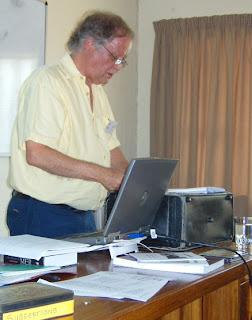By Penny Evans
On 21 January 2012 Neels Coertse gave a talk to the West Gauteng branch of the GSSA on the poor white question in South Africa.
 |
| Neels Coertse with his technical equipment. |
The second group were those who had left the farming community. This group included those who had moved to rural villages and become poor whites, those who had moved to industrialized towns and who made a living as poorly skilled labourers and those who moved to the diamond diggings. Projects such as the building of dams employed many unskilled labourers.
The causes of inadequate adaption were discussed in the report. The heritage of the Groot Trek, the Anglo Boer War and rapid development of agriculture and the railways were factors. People were not prepared for these changes. The development of mining and industry caught the farmers unprepared. Education did not keep up with the rapid changes taking place in South Africa. Vocational and technical training was regarded as being inferior. Poor work ethic and social isolation had a negative effect on the well being of the people.
The commission realized that assistance was needed in order to deal with the problem and recommended improving farming methods and introducing agricultural training. Education to eliminate illiteracy, instilling a culture of reading, using better teaching methods and resources. School hostels for needy children. Special schools for children with special needs. Compulsory schooling till fifteen years of age. Use of the radio to educate farming communities. State assistance was needed to improve teacher training. Facilities for adult education were needed. Life skills had to be addressed and improved.
Data was collected regarding the high death rate. These factors were poor sanitation, overcrowded living conditions, water pollution, malaria, malnutrition and epidemic illnesses.
The value of the mother in the household was recognized. She had to be educated in healthier ways of food preparation and encouraged to grow vegetables. Continuous education was needed concerning ill health and care of babies. There was a need to develop clinics. A basic knowledge of nursing was needed. Isolation and lack of stimulation contributed to a lack of family development.
The commission felt that the aim of giving assistance to the poor was to help people to help themselves.
Throughout his talk Neels Coertse continually drew parallels between our historical background and our present society. This was an interesting and well researched talk.
